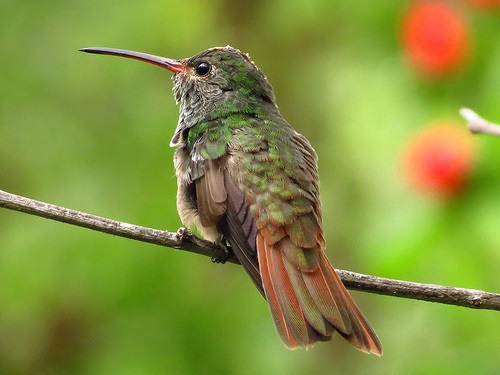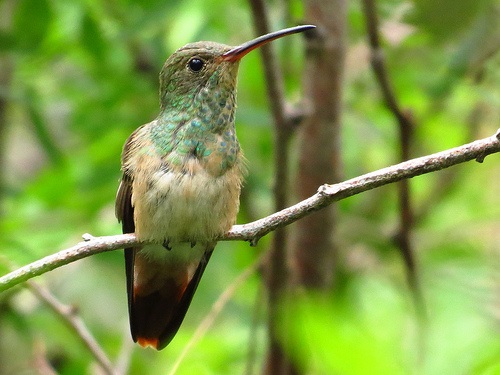Migrating birds are continuing to show up little by little as fall migration progresses. Ruby-crowned Kinglet and Orange-crowned Warblers are a couple of the later-arriving migrants that were seen this morning. While scanning the radiantly-red turk’s cap flowers along Birding Creek, the forceful chatter of a Buff-bellied Hummingbird was heard. After drawing our attention to the call notes we saw swaying stalks and leaves where this hummingbird was flying. It was such a treat to see this beautiful Buff-bellied Hummingbird hover and feed as it probed the freshly-opened turk’s cap flowers.
Green Jays gave their squawky call notes, marking their feeding territories to other jays in the area. As they leaped from branch to branch throughout the mature oak tree, the jays gobbled up acorns found hidden among the leaves. Green Jays feed readily on sunflowers and suet too. They can’t help but show off their endless shades of lime green and ocean blue.
We continued to walk towards Ebony Grove after visiting Birding Creek. As we stood below the palm snags we heard and saw Golden-fronted Woodpeckers feeding over our heads. They gave their sharp call notes as the probed up and down the tree trunks looking for insects to eat.

Look carefully and you’ll see the bright yellow “front” of this bird’s forehead. That is where the name Golden-fronted Woodpecker originates!

First heard then seen, the buzzy “bzzt” call note caught our attention as we spotted this female Indigo Bunting.
Below is the eBird checklist form this morning’s Songbird Stroll. Be sure to join us next Saturday from 8:00-9:30 as we look for recently-arrived migrating birds!
Black-bellied Whistling-Duck 50
Plain Chachalaca 20
Inca Dove 10
White-winged Dove 12
Mourning Dove 4
Common Pauraque 1
Ruby-throated Hummingbird 2
Buff-bellied Hummingbird 2
Golden-fronted Woodpecker 6
Ladder-backed Woodpecker 2
Great Kiskadee 2
Couch’s Kingbird 2
Green Jay 2
Barn Swallow 5
Cave Swallow 3
Verdin 1
House Wren 2
Carolina Wren 1
Blue-gray Gnatcatcher 4
Ruby-crowned Kinglet 1
Clay-colored Thrush 15
Curve-billed Thrasher 8
Long-billed Thrasher 1
Northern Mockingbird 6
European Starling 2
Black-and-white Warbler 1
Orange-crowned Warbler 1
Olive Sparrow 3
Northern Cardinal 2
Indigo Bunting 1
Great-tailed Grackle 20
Bronzed Cowbird 2
House Sparrow 15
Good birding,
Erik Bruhnke








